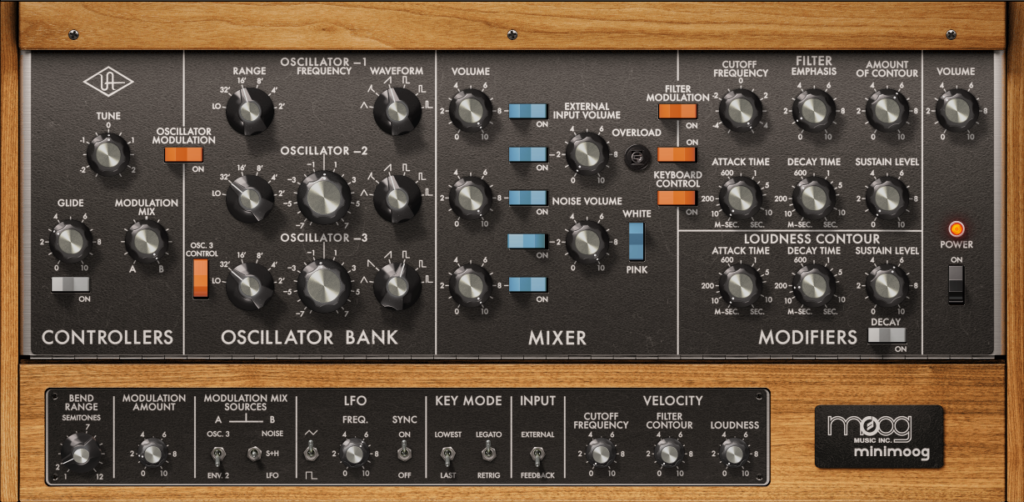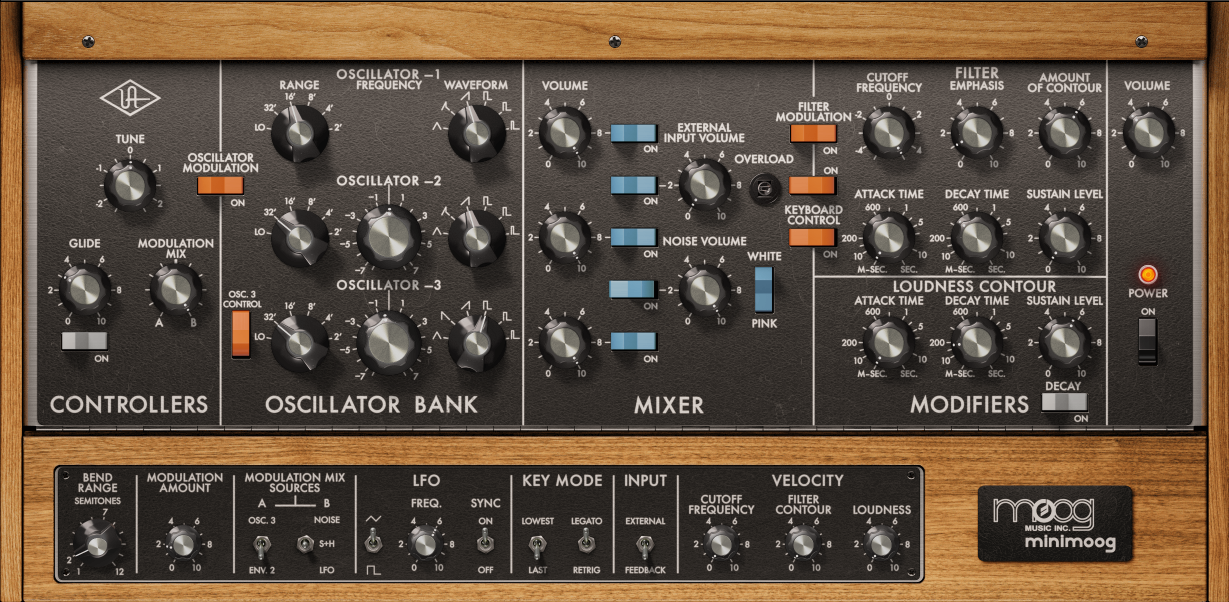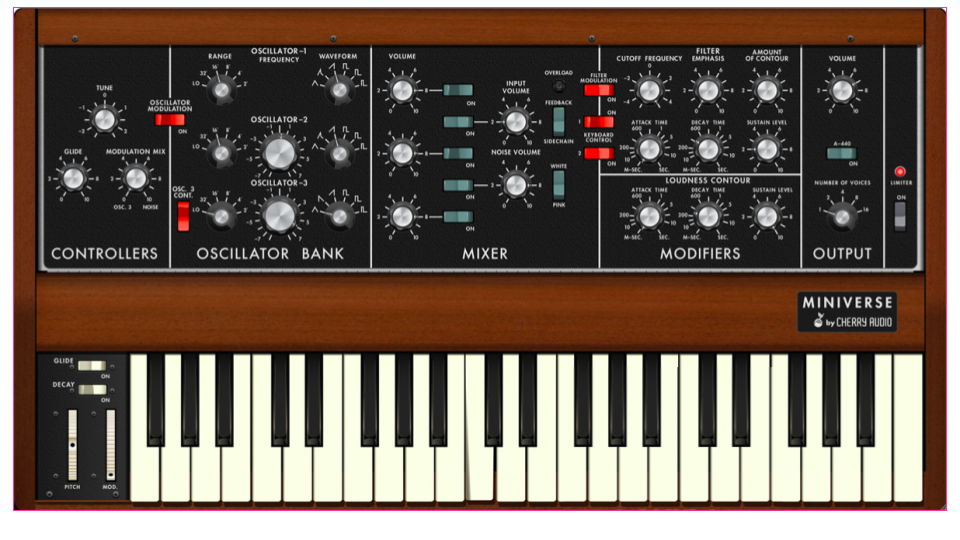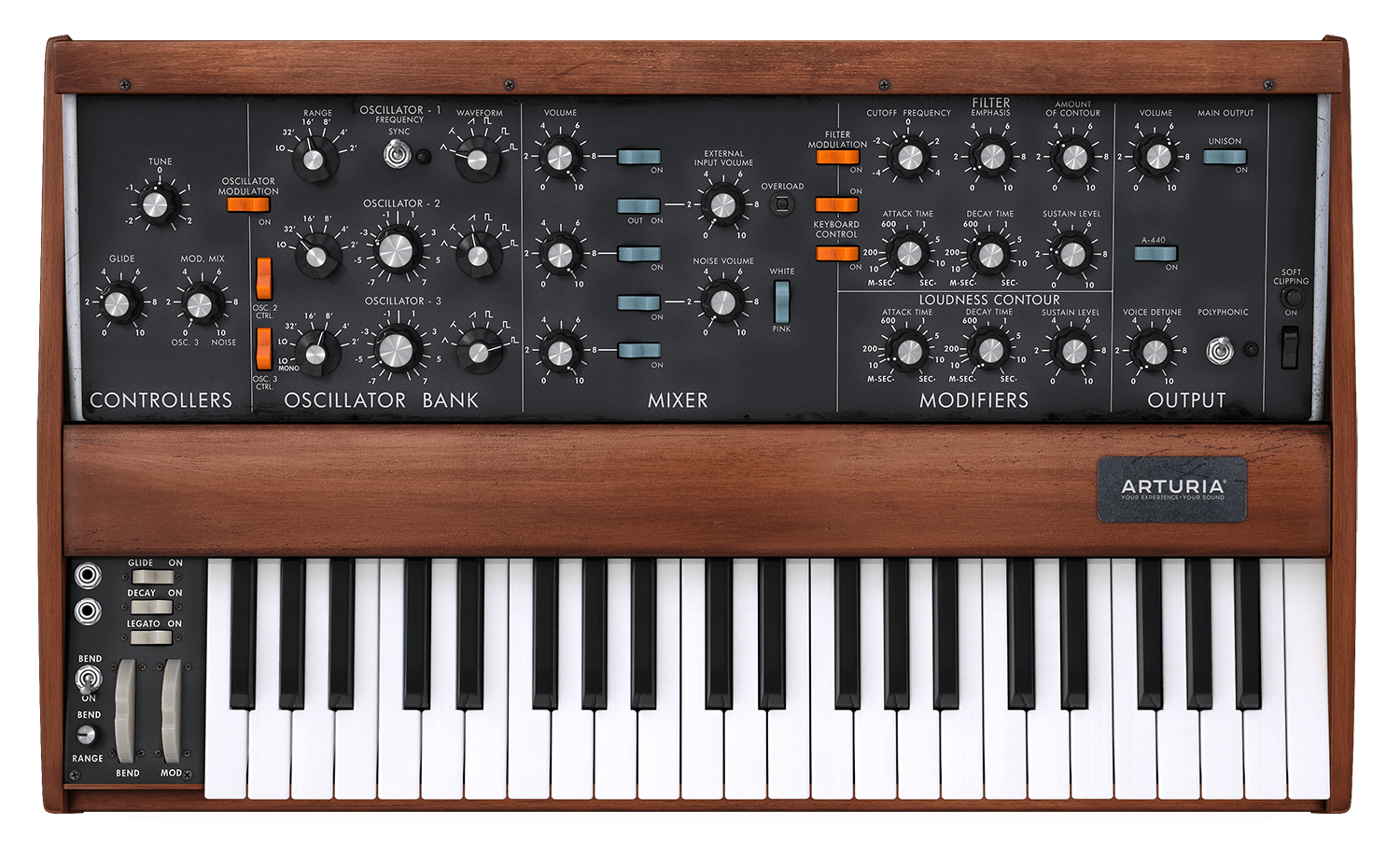There have been several attempts to recreate the Minimoog Model D as a software instrument. Some of them get really close.
But only the UAD Minimoog by Universal Audio actually has the official Moog name attached to it. So there’s a heavy expectation that it’ll sound just like the real thing.
Does it stack up?
What Is UAD Moog Minimoog?
Universal Audio’s Minimoog is a virtual recreation of the legendary Minimoog Model D. It’s part of the UAD line of plugins, and was co-developed with Moog Music. It features a user interface that looks and functions just like the original synth. More importantly, it sounds just like the original too.
Minimoog is available in multiple formats and compatible with every major DAW.
The official software version of the Minimoog Model D, co-developed by Universal Audio and Moog Music. This faithful recreation captures all the subtle nuances of the original while adding a handful of modern features. It's easily the most authentic-sounding Minimoog clone available today.
- Most authentic-sounding Minimoog clone
- GUI replicates the original instrument's UI
- Dedicated LFO frees up the 3rd Oscillator
- Additional enhancements for modern workflows
- Lacks polyphonic support
UAD Minimoog Features
Universal Audio got a lot of things right with this plugin. Here’s everything I like about it:
Perfectly Replicated Sound
I’m lucky enough to have tried an original Minimoog from the 1970s — my college’s music studio had one available for a handful of projects.
While that was several years ago at this point in time, it made a lasting impression on me.
I’ll admit, it might be the rose-tinted glasses at work. But in my mind, the UAD version comes the absolute closest to replicating the original instrument’s sound. It’s got that delicious warmth and gritty texture you’d expect from a Moog synthesizer.
Other plugins have come really close to matching its sound. But they still sound a little flat and digital, and lack that indescribable “charm”. I want to say most of that comes down to how the waveforms from each oscillator interact with each other.
Recreated Minimoog GUI
The Model D’s interface is pretty straightforward. You have your three oscillators, plus some additional controls for the mixer, filter, and envelope.
UAD Minimoog recreates that same interface in exact detail — every switch and dial is in the same place and performs the same function.
And to add to the charm, it looks just like the original synth down to the wood panels and leather control surface.


Improvements Over the Original
UA’s Minimoog has a few quality-of-life enhancements that make it more functional for your DAW.
You’ll find most of them at the bottom in the Modifications Panel. I won’t go into everything here, I’ll just highlight some of my favorite new features:
- Extra LFO — This frees up Oscillator 3 for sound generation while using a dedicated LFO for modulation effects like vibrato.
- Velocity controls — Allows MIDI velocity to control parameters for Loudness, Frequency Cutoff, and Filter Contour. That way, you can add more human elements to your performance.
- Legato/Retrigger switch — The original Model D defaulted to a legato mode. You can choose whether notes stay legato and glide between each other, or if the envelope retriggers each time you press a note.

More Cost-Effective Than the Actual Minimoog
Getting your hands on an actual Model D hardware synth isn’t exactly cheap.
Today, an original Minimoog from the ’70s can sell for well over $10,000. And even the modern reissues retail for about $5,000 each.
As far as software goes, Universal Audio’s offering is easily the next best thing.
Polyphony: The One Thing That Could Make the Minimoog Better
The UAD Minimoog is the most faithful adaptation of the original — almost to a fault.
If you didn’t know, the Model D is a monosynth, meaning it only plays one note at a time. So while it works great for leads, arps, and basses, you can’t use it for chords and pads without recording multiple takes.
Same thing with this software version, which is the UAD Minimoog’s Achilles heel.
On the one hand, a 1:1 recreation of the original Minimoog is amazing. It’s an incredible value, especially when you compare the price to actual Moog synthesizers.
But on the other hand, it’s a software synth released in 2022. So it isn’t bound by the hardware limitations of 1970.
Keeping it mono-only was a deliberate choice by UA and Moog Music. But in my mind, adding polyphony would have made this synth way more versatile and user-friendly. As a result, it would have been an easy recommendation over other Minimoog clones like it.
Do You Need an Apollo Interface to Use the UAD Minimoog?
No. That might have been the case with Universal Audio plugins in the past.
But now, they’re available in VST, AU, and AAX formats. So you can run them natively in any DAW without any issues.
Do You Need an iLok Account to Use the UAD Minimoog?
All Universal Audio plugins require an iLok registration to use them. Once you download the Minimoog or any UA plugin, you’ll need to link it to your iLok account and activate the license to your computer, an iLok device, or the iLok cloud server.
UAD Minimoog Alternatives
There are other Minimoog software clones out there. Most of them sound close enough to the real thing that your listeners won’t notice or care. Plus, they offer polyphony.
A few in particular stand out in my mind:
-
$39Check Plugin Boutique Check Sweetwater
A budget-friendly digital version of the iconic Minimoog. It maintains the spirit of the original instrument while also adding polyphony. Get this virtual synth to add some phat analog sounds to your music.
We may earn a commission if you make a purchase, at no additional cost to you.
-
$149Check Plugin Boutique Check Sweetwater
An incredibly accurate and detailed recreation of the legendary Minimoog. Plus, it comes with modern enhancements like polyphony, standalone LFO modulation, and other effects.
We may earn a commission if you make a purchase, at no additional cost to you.
Final Verdict: Is UAD Minimoog Worth It?
If you want the most authentic-sounding Minimoog clone out there, there’s nothing better than the UAD Minimoog. It looks, sounds, and feels just like the original instrument. And the fact that it was co-developed by Moog Music speaks volumes about its authenticity.
Some people might have a hard time justifying the price, or could be disappointed in the lack of polyphony. In which case try one of the other alternatives I mentioned.
But if you want the real deal, getting UA’s Minimoog is worth it.
The official software version of the Minimoog Model D, co-developed by Universal Audio and Moog Music. This faithful recreation captures all the subtle nuances of the original while adding a handful of modern features. It's easily the most authentic-sounding Minimoog clone available today.
- Most authentic-sounding Minimoog clone
- GUI replicates the original instrument's UI
- Dedicated LFO frees up the 3rd Oscillator
- Additional enhancements for modern workflows
- Lacks polyphonic support


